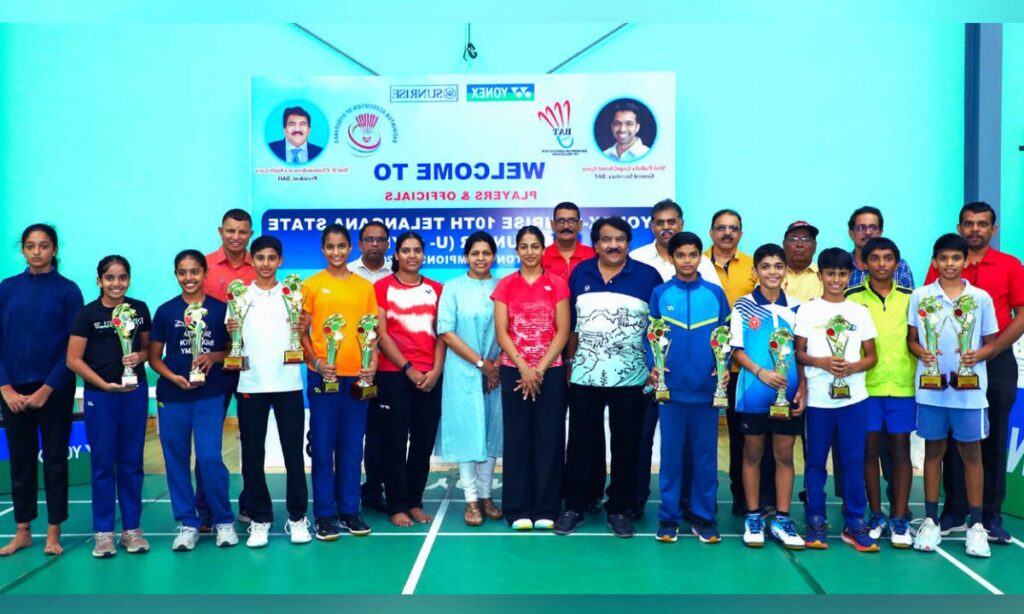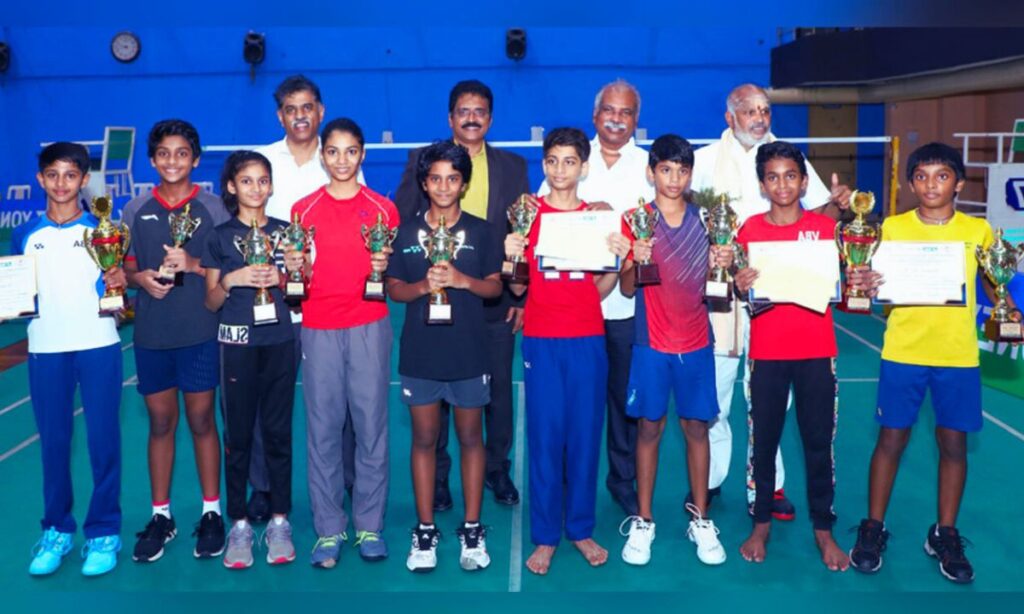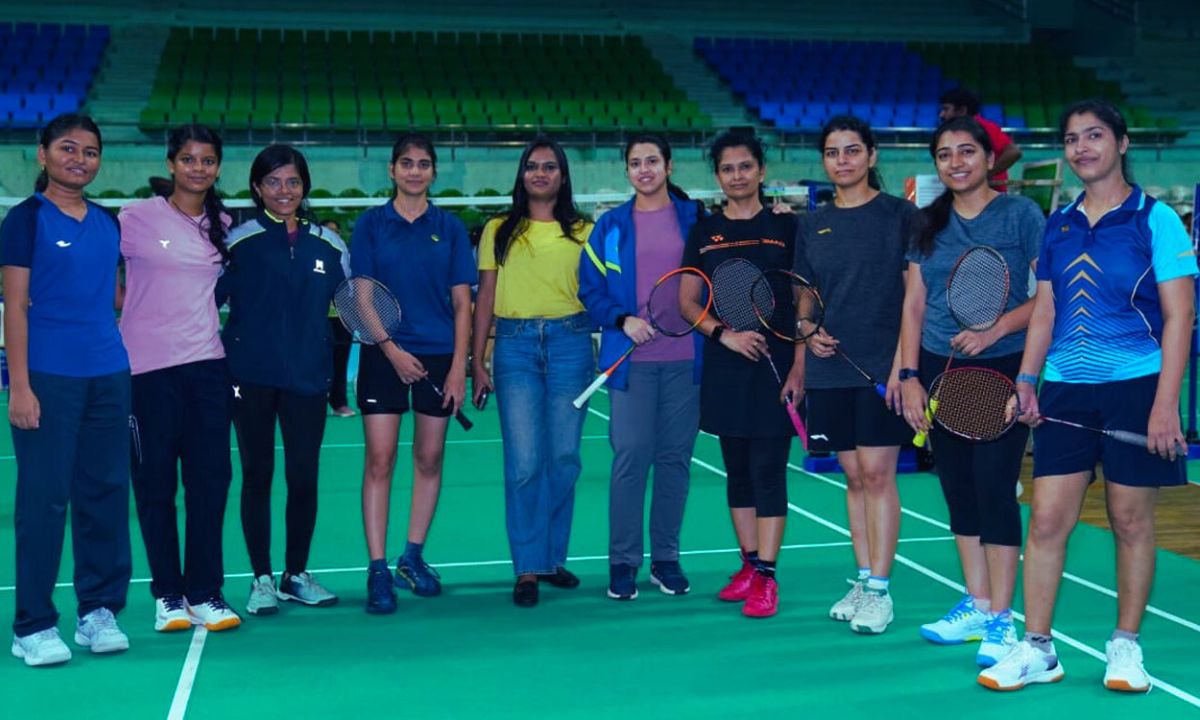Tensions were high as Northern Region‑I and Corporate Centre (CC) met in the men’s team final at the KVBR Indoor Stadium in Yousufguda. In a gripping match, Northern Region‑I edged CC with a 3‑1 victory. That success brought relief and satisfaction to their side—but a sense of vulnerability for CC, who had eyes on both titles.
Men’s Final: Northern Region‑I Strikes Early
Northern Region‑I asserted dominance from the first scoreline. In the opening men’s singles, B. Himanshu dismantled Arpit convincingly, 21‑12, 21‑7. The blow was crushing for CC and set the tone for the rest of the night.
CC Hits Back, But Faces a Steep Climb
Arpit’s loss was softened when Pintoo of Northern Region‑I fell to CC’s Hari Kishore in straight games. That 21‑14, 21‑13 win gave CC hope and briefly shifted the momentum, announcing they weren’t out yet.
Doubles Drama Turns Result in NR‑I’s Favor
In what turned into a decider, the Northern Region‑I duo—Manish and B. Sanket—outfoxed Hari Kishore and Arpit in a tight 21‑18, 21‑19 match. Their clever net play and relentless attitude swung the tie firmly back to their side.
Sanket Seals the Deal with Dominance
Finally, Sanket’s smashing singles win over Rajesh (21‑4, 21‑15) sealed the match. The electric finish left no doubt—Northern Region‑I had claimed the men’s title with authority.

Women’s Final: CC Redeems Itself Against Western Region
While Northern Region‑I lifted the men’s trophy, CC rose to the occasion in the women’s final. They turned the pressure around to beat Western Region‑I 2‑1, snatching their own moment of glory.
Singles Sparked Confidence: Sonali Leads the Charge
In the first women’s singles, Sonali turned early nerves into composure. She triumphed over Aditi with a strong 15‑11, 15‑11 win—energizing CC’s bench and rattling the opposition.
Doubles Drama Again: Mishi & Kiran Deliver the Decider
The second match—women’s doubles—was packed with emotional surges. Mishi and Kiran staved off early loss, beating Sonali and Gaikwad in three hard-fought games (13‑15, 15‑12, 15‑6). That comeback breathed life into CC’s campaign.
Final Singles: Nishi’s Poise Closes the Match
Under pressure and the weight of expectation, Nishi delivered a sharp performance to seal the victory, beating Sonal Gaikwad 15‑4, 15‑8. The classy finish lifted CC to their well-deserved women’s team trophy.
Consolation Battles Shine: Third Places Confirm Depth
Northern Region‑II and Eastern Region‑II battled for men’s semi-final losers’ placement. Northern Region‑II prevailed 3‑1, buoyed by clutch shots from Akashu and consistent pressure from Iqbal & Akash in doubles, and a final edge by Rakesh over Pramod.
Women’s Consolation: NR‑I Displays Balanced Strength
In the women’s third-place showdown, Northern Region‑I dispatched Southern Region‑II 2‑0. Pinki and Mishi & Kiran both delivered straight‑sets victories to claim the minor podium spot.
A Showcase of Strategy, Nerves, and Bold Strokes
Across both divisions, the championship illustrated the critical interplay of strategy, patience, and nervous resolve. Singles matches shifted on early breaks, while doubles pairs revealed how trust and rhythm can reverse pressure.
Why These Wins Matter Beyond the Scoreboard
For the players, these victories are more than medals—they are resume builders, confidence boosters, and validation of hours of training. Northern Region‑I’s win hints at emerging dominance, while CC proves they can rebuild under fire.
What It Means for Future Circuit
These titles can shape regional momentum. Emerging stars like Himanshu, Sanket, Sonali, and Nishi might now attract more attention, support, or national-level opportunities. Their performance suggests both depth and hunger in regional badminton talent.
Focus on Teamwork and Psychological Edge
What stood out was the emphasis on psychological control—teams that defended better under pressure edged matches. Coaches across regions noted strong doubles cohesion under critical points and singles resilience when trailing.
A Mix of Drama and Poise That Lingers
For fans and observers, this championship delivered the thrill of reversals, tight finishes, and confident winners—and a few heartbreak stories. Those moments—the smell of sweat, the bounce of shuttle, the cheering echo—are what make tournaments memorable.
What Could Have Been: Where Teams Fell Short
One negative edge: CC men’s singles loss highlighted vulnerability early in the tie. Meanwhile, Western Region women let go after winning the opening point. These small cracks under pressure proved decisive and illustrate where they must improve.
Men’s Final: A Hard-Fought Triumph for Northern Region‑I
Northern Region‑I opened their title chase with a commanding singles win. B. Himanshu dismantled CC’s Arpit 21‑12, 21‑7, setting the tone early and underlining the aggressive intent Northern Region‑I brought to the court.
After that initial blow, CC answered back through Hari Kishore’s dominant singles win. Taking the second match 21‑14, 21‑13, he showed precision and calm under pressure, shifting momentum.
But the doubles partnership from Northern Region‑I, Manish and B. Sanket, delivered the pivotal point. Their tight 21‑18, 21‑19 victory stemmed from perfect rhythm and smart net play—revealing their poise in crucial moments.
Sanket then closed out the tie in style. A 21‑4, 21‑15 demolition of Rajesh was clinical and confident—a visible statement from NR‑I that they meant business.
Women’s Final: CC Strikes Back With Grace
In the women’s final, CC turned adversity into confidence. Sonali’s opening singles win over Aditi (15‑11, 15‑11) delivered the spark CC needed to balance the tie early on.
Doubles made the difference. Mishi & Kiran recovered from an unfortunate first game to edge their match in three tense sets (13‑15, 15‑12, 15‑6), showing nerves of steel under pressure.
Nishi brought CC home with a composed final singles performance. Her 15‑4, 15‑8 win sealed the tie and lifted the trophy in front of an energetic crowd.
Consolation Rounds: Depth on Display
Northern Region‑II grabbed third place in the men’s event thanks to balanced contributions. Akashu’s singles win in two solid games and Iqbal & Akash’s doubles edge carried them past Eastern Region‑II.
In women’s consolation, Northern Region‑I beat Southern Region‑II 2‑0. Pinki and Mishi & Kiran both delivered composed, straight‑sets victories—emphasising consistency across categories.
Momentum Swings and Psychological Edges
A key factor throughout was momentum management. Teams that came back from behind displayed composure—often turning the deciding point in a match with aggressive shot‑making and calm heads.
Single errors in doubles proved costly. Teams that held conviction in tight moments were rewarded with crucial points—highlighting that mental toughness matters as much as skill.
For those who lost late matches, the regret was visible. Teams like CC men’s side held early promise but lost composure in doubles, illustrating small margins between victory and defeat.
Player Focus: Rising Stars to Watch
B. Himanshu and Sanket emerged as standouts. Himanshu’s explosive singles play and Sanket’s finishing spirit hint at players hungry for national recognition.
On the women’s side, Sonali, Mishi, and Nishi rose to the occasion. Their fighting spirit in singles and doubles underline CC’s depth and mirrored a growing culture of discipline and teamwork.
Coaching Influence and Strategy
Behind each win were coaches who shaped strategy. Northern Region‑I’s doubles bench clearly planned set recovery tactics; CC’s women planned graceful shift after singles setbacks.
Team captains and leaders leaned on psychology. Encouraging words after a lost game, quick tactical adjustments—those subtle decisions shaped match outcomes.
Infrastructure and Training Takeaways
The tournament revealed how regional training systems bear fruit. Coaches attributed success to dedicated indoor facilities, structured training regimes, and supportive leadership.
Teams with consistent doubles partnerships gained an edge. The value of pairing experienced players repeatedly was evident in tight third‑set matches.
Event Atmosphere and Local Excitement
Packed bleachers pulsed with energy. Spectators responded to each comeback and rally, adding collective adrenaline that fed into players’ resolve.
Post-match celebrations gave glimpses of character—handshakes and hugs between competing teams, genuine sportsmanship and respect.
Broader Significance of the Championship
Success at these inter-regional tournaments acts as a stepping stone for national-level trials, junior squads, and even selection committees. Players now on coaching radars expect further opportunities.
It’s a showcase of India’s badminton depth beyond metros. Regions like Northern Region‑I and CC are cultivating talent that can challenge traditional powerhouses.
Observations and Room for Growth
Some teams showed inconsistency across disciplines. CC men’s team faltered in doubles after promising singles; improving depth remains a mission.
Southern and Western regions produced flashes of brilliance but lacked finishing strength. Investing in mental toughness and recovery training may close gaps.
Legacy, Promise, and Passion
Northern Region‑I’s win and CC’s resilience tell a larger story: regional pride, collective ambition, and emerging stars committed to excellence.
The court energy, shuttle speed, and players’ determination created a sensory spectacle—one that lingers with fans hungry for bold young talent.
That mix of disappointment and joy after each match reminds us sports is about emotion as much as results.
As the trophy was lifted and applause rose, readers were left with two powerful messages: structured regional training breeds contenders, and sporting culture thrives on every grassroots court.
Looking ahead, these names may well appear on national teams. Today’s regional finals are tomorrow’s international showcases.
For now, the legacy begins locally. And in places like Yousufguda, the spark of passion continues to burn bright.
Why This Tournament Matters More Than You Think
This was more than a sports tournament. It was a stage where dreams met reality. For many players, this might be their only national spotlight this year, making every point, every rally, every victory, intensely personal.
Coaches described it as a turning point in many players’ careers. Perform well here, and you could be selected for higher camps. Struggle, and your name might not be called again this season.
Sponsors and scouts were watching too. Badminton in India has become more competitive than ever, and events like this give companies and sports agencies a chance to identify rising stars early.
Additionally, the inter-region format creates rivalries and camaraderie. You could see it on the court—respect for competitors, but an undeniable desire to outperform and prove your region’s strength.
Seductive Speed, Tactical Brilliance, and Pure Grit
One of the most intoxicating aspects of this tournament was the speed. Shuttles flew at blistering pace, and players had milliseconds to react. It wasn’t just physical—it was mental warfare.
Strategy played a huge role. Coaches weren’t just shouting encouragement—they were signaling shifts, calling timeouts, and correcting footwork. Tactical nuances turned matches around in real time.
Doubles games, in particular, were sensory rollercoasters. The synchronized movements, fast exchanges at the net, and wild cross-court smashes kept the audience gasping.
Grit defined the tournament. Whether it was a comeback from five points down or diving to keep a rally alive, players pushed their limits to break through.
Hidden Heroes: Those Who Don’t Make Headlines
Not every player received a trophy, but many earned respect. Take Rakesh from Northern Region‑II. His relentless fight in the third-place playoff was admired by coaches and competitors alike.
Then there was Aditi from Western Region. Despite losing her match, her footwork and stamina drew praise from senior officials. It’s often these little sparks that ignite long-term potential.
Volunteers and organizers also made a big impact. From keeping the courts clean to managing live scores, their invisible work ensured the players could shine without disruption.
The local fans in Yousufguda added to the magic. Many had never seen live badminton before, yet their enthusiasm brought energy that turned the stadium into a roaring arena.
The Mental Game: More Than Just Physical Talent
Beyond strength and speed, what truly separated the champions from the rest was their mindset. Players like B. Himanshu and Sonali didn’t just hit harder—they stayed calm under pressure, adapted mid-match, and refused to crack. It’s this mental steel that makes a real difference when matches go the distance.
The pressure of representing an entire region weighs heavily on young shoulders. And yet, many athletes embraced it. They didn’t just play—they performed, fully aware of who they were representing. For some, this pressure turned into power; for others, a lesson in composure they’ll carry forward.
Coaches repeatedly emphasized mindfulness and emotional control throughout the tournament. Between rallies, players were encouraged to center themselves, shake off mistakes, and reset. These tiny psychological techniques proved decisive in close matches, especially in the nerve-wracking final sets.

Why This Story Needs to Be Told
Stories like these—real, raw, and richly layered—often get buried beneath headlines about global stars. But grassroots tournaments are where the future of Indian badminton is truly being shaped. Every smash, every dive, every silent sacrifice deserves to be seen and celebrated.
As the stadium lights dimmed and the final shuttle fell, a powerful truth echoed through the corridors of KVBR Indoor Stadium: champions aren’t just born—they are built match by match, point by point, moment by moment. And this championship reminded all of us why we love the game.
Legacy of the KVBR Indoor Stadium and Local Pride
The KVBR Indoor Stadium isn’t just a venue—it’s a symbol of Hyderabad’s love for sports. Over the years, it has hosted many tournaments, but this one felt especially emotional for local spectators.
For young fans sitting in the stands, this was inspiration in motion. Several children, eyes wide with excitement, could be seen mimicking players’ moves between matches.
The event also put Hyderabad back on the badminton map. Often overshadowed by cities like Bengaluru or Delhi, this tournament reminded everyone of Telangana’s badminton heritage.
There’s also the pride of hosting. Local businesses, families, and badminton academies rallied behind the event, offering support, cheering players, and giving it the warmth that can’t be faked.
What Comes Next for These Players
For those who won, the road ahead is about staying hungry. Success can be fleeting in a sport like badminton where new talent emerges each season. The key is consistency.
For those who fell short, reflection is vital. Analysing match videos, identifying weaknesses, and coming back stronger will determine their journey in future tournaments.
Players like Sanket, Himanshu, Nishi, and Sonali may soon find themselves invited to state-level camps or federation trials. Their performance here was too good to ignore.
Even losing teams gained valuable match experience. Those hard-fought points and close finishes act as learning curves for both players and coaches.
Final Thought: Legacy Starts Locall
Such regional championships form the crucible of national competitors. When promising players from Northern Region‑I and CC train consistently and mentally sharpen their game, they pave the way for future national representation. This passion and promise give readers a sensory sense of hope and rise.

